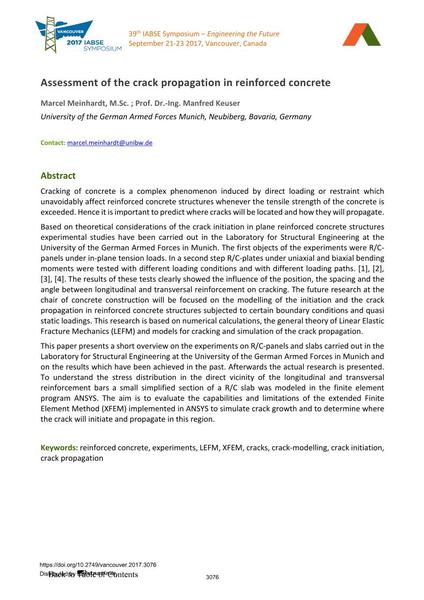Assessment of the crack propagation in reinforced concrete

|
|
|||||||||||
Bibliografische Angaben
| Autor(en): |
Marcel Meinhardt
(University of the German Armed Forces Munich, Neubiberg, Bavaria, Germany)
Manfred Keuser (University of the German Armed Forces Munich, Neubiberg, Bavaria, Germany) |
||||
|---|---|---|---|---|---|
| Medium: | Tagungsbeitrag | ||||
| Sprache(n): | Englisch | ||||
| Tagung: | IABSE Symposium: Engineering the Future, Vancouver, Canada, 21-23 September 2017 | ||||
| Veröffentlicht in: | IABSE Symposium Vancouver 2017 | ||||
|
|||||
| Seite(n): | 3076-3083 | ||||
| Anzahl der Seiten (im PDF): | 8 | ||||
| Jahr: | 2017 | ||||
| DOI: | 10.2749/vancouver.2017.3076 | ||||
| Abstrakt: |
Cracking of concrete is a complex phenomenon induced by direct loading or restraint which unavoidably affect reinforced concrete structures whenever the tensile strength of the concrete is exceeded. Hence it is important to predict where cracks will be located and how they will propagate. Based on theoretical considerations of the crack initiation in plane reinforced concrete structures experimental studies have been carried out in the Laboratory for Structural Engineering at the University of the German Armed Forces in Munich. The first objects of the experiments were R/C- panels under in-plane tension loads. In a second step R/C-plates under uniaxial and biaxial bending moments were tested with different loading conditions and with different loading paths. [1], [2], [3], [4]. The results of these tests clearly showed the influence of the position, the spacing and the angle between longitudinal and transversal reinforcement on cracking. The future research at the chair of concrete construction will be focused on the modelling of the initiation and the crack propagation in reinforced concrete structures subjected to certain boundary conditions and quasi static loadings. This research is based on numerical calculations, the general theory of Linear Elastic Fracture Mechanics (LEFM) and models for cracking and simulation of the crack propagation. This paper presents a short overview on the experiments on R/C-panels and slabs carried out in the Laboratory for Structural Engineering at the University of the German Armed Forces in Munich and on the results which have been achieved in the past. Afterwards the actual research is presented. To understand the stress distribution in the direct vicinity of the longitudinal and transversal reinforcement bars a small simplified section of a R/C slab was modeled in the finite element program ANSYS. The aim is to evaluate the capabilities and limitations of the extended Finite Element Method (XFEM) implemented in ANSYS to simulate crack growth and to determine where the crack will initiate and propagate in this region. |
||||
| Stichwörter: |
Stahlbeton Rissausbreitung Rissinitiierung LEFM
|
||||
